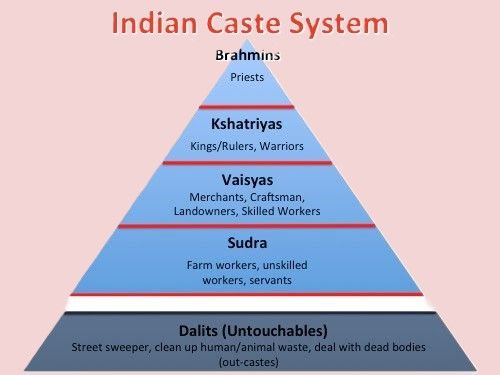
The caste system in ancient India represents a complex and hierarchical order of social structure that has its roots deeply embedded in the Vedic texts and the socio-economic fabric of early Indian civilization. Its origin is somewhat nebulous, with the earliest references emerging from the Rig Veda. Here, a segmented society is hinted at, comprising four primary varnas: Brahmins, Kshatriyas, Vaishyas, and Shudras, arranged in descending order of authority and respectability. Over the centuries, this social stratification evolved, becoming more rigid and intertwined with heredity, significantly shaping the cultural landscape of ancient India.
Origins of the Caste System
The Rig Veda, composed around 1500 BCE, contains the earliest traces of a societal hierarchy, where the Brahmins (priests and scholars) occupy the highest tier, followed by Kshatriyas (warriors and rulers), Vaishyas (merchants and agriculturalists), and Shudras (laborers and service providers). The fourth varna, Shudras, is often interpreted as emerging from the union of Aryans and non-Aryans, illustrating a nuanced blend of ethnic and occupational identities.
The Bhagavad-Gita, another crucial text, further elaborates on the genesis of castes based on inherent qualities (guna) and duties (dharma) rather than solely lines of inheritance. This shift suggests that the caste framework may have initially permitted some flexibility regarding social mobility based on personal merit.
Caste in the Vedic Age
During the Vedic period, which encompasses the time when the Vedas were composed, the distinction between high and low occupations was less pronounced. Economic activities did not inherently reflect social status; for instance, artisans and laborers were not held in contempt as seen in later texts. The term Dasa referred to certain non-Aryan groups who lived in urban settings and engaged in agriculture, indicating their integration into societal functions rather than complete subjugation.
As texts transitioned from the Vedic phase to the period of the Brahmanas, however, the status of Shudras became notably less favorable. The Brahmanas, commentaries on the Vedas, insinuated that Shudras were subservient and could be ejected or harmed without consequence. This marked a shift towards a more hierarchical caste system where social mobility for lower castes was increasingly restricted.
The Brahmanical Shift
The Brahmanical texts, which emerged around 600 BCE to 200 CE, provide a more detailed account of the social structure. They affirm that Shudras were perceived as "servants" to the higher castes and were often excluded from sacred rites and performances. This period also cemented the notion that social roles were largely hereditary and adhered to through generations.
While the Kalpasutras (ritual texts) highlighted the disabilities of Shudras, such as their prohibition from Vedic studies and rituals, they also articulated a subtle shift towards some recognition of their rights. Shudras were allowed to acquire property and could participate in certain rituals, reflecting an evolving understanding of social legitimacy.
Caste System in the Age of Epics
The Ramayana and Mahabharata, two pivotal epics composed between 400 BCE and 400 CE, illustrate the entrenched social hierarchy while also offering glimpses of flexibility within the caste system. Shudras served as laborers and servants, often subjected to various restrictions, yet the epics also narrate episodes where individuals from lower castes could ascend social ranks through discipline, valor, or exceptional talents. This suggests the existence of pathways for transcending caste boundaries, albeit limited and exceptional.
The Mahabharata reveals a more complex tapestry of social stratification, incorporating numerous sub-castes and detailing the elaborate nuances of caste relationships, inter-dining, and marriage. Despite the portrayal of strict caste delineations, characters like Ekalavya demonstrate the potential for merit to challenge traditional boundaries.
Additionally, the Smriti literature (texts on traditional law and ethics) details numerous restrictions placed upon Shudras, reinforcing their subordinate status while simultaneously acknowledging their roles in society. The Jataka tales, a collection of stories narrating the previous lives of Buddha, also provide insights into lower-class individuals, illustrating their struggles and the societal norms governing their lives.
Conclusion
The caste system in ancient India evolved into a highly structured and rigid framework, informed by religious, economic, and socio-political factors. Starting with a more fluid categorization of roles in the Vedic age, the system progressively calcified into an inheritance-based hierarchy by the time of the Brahmanas and the epics. While the initial premises allowed some degree of social mobility based on merit, this became increasingly constrained in later texts, culminating in a societal structure that imposed significant limitations on the Shudras and other lower castes.
Understanding the intricacies of the caste system in Ancient India provides valuable insights into the culture and history of the region, illuminating the tensions between social stratification and individual potential that continue to resonate in contemporary discussions on caste and social justice. The evolution of this system reflects broader themes of power, identity, and the ever-changing dynamics of Human societies.